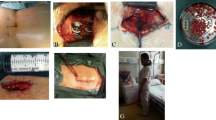Abstract
Introduction
Implant removal because of pain after posterior fusion in the thoracic and lumbar spine is a widely performed operation. We conducted a retrospective study to examine whether patients benefit from implant removal.
Patients and methods
57 patients (29 males, 28 females, mean age 46.5 years) who have undergone removal of pedicle screws because of pain and discomfort were interviewed 6–24 months postoperatively. Fracture was the initial diagnosis in 40% of the patients and degenerative spine disease in 58%. The following factors were evaluated: patient satisfaction and postoperative outcome, patients’ native language and psychological background, operative data, hospital stay and complications.
Results
Pain decreased significantly from 62 to 48 on visual analogue scale postoperatively. Complications occurred in five patients (8.8%). 36 patients (61%) stated they had some benefit from the operation, but only seven patients (12%) were free of pain completely. 36 patients (63%) would undergo the same procedure again. Outcome in the subgroup of foreigners was significantly worse, though the psychological background did not affect the outcome. Preoperative diagnostic infiltration was helpful in 9 of 13 patients.
Conclusion
Removal of pedicle screws because of back pain may be effective, but complete remission of symptoms could be achieved in only 12% of patients. However, 63% of patients would undergo hardware removal again. Preoperative diagnostic infiltration can help to predict the outcome but results are inconsistent. Communication difficulties may worsen the outcome. Surgeons should consider these results when planning implant removal and patients should be informed thoroughly to avoid too high expectations.
Similar content being viewed by others
References
Bostman O, Pihlajamaki H (1996) Routine implant removal after fracture surgery: a potentially reducible consumer of hospital resources in trauma units. J Trauma 41(5):846–849
Brown RM, Wheelwright EF, Chalmers J (1993) Removal of metal implants after fracture surgery—indications and complications. J R Coll Surg Edinb 38(2):96–100
Richards RH, Palmer JD, Clarke NM (1992) Observations on removal of metal implants. Injury 23(1):25–28
Sanderson PL, Ryan W, Turner PG (1992) Complications of metalwork removal. Injury 23(1):29–30
Deckey JE, Court C, Bradford DS (2000) Loss of sagittal plane correction after removal of spinal implants. Spine 25(19):2453–2460
Wild A, Pinto MR, Butler L, Bressan C, Wrobleswski JM (2003) Removal of lumbar instrumentation for the treatment of recurrent low back pain in the absence of pseudarthrosis. Arch Orthop Trauma Surg 123(8):414–418
Alanay A, Vyas R, Shamie AN, Sciocia T, Randolph G, Wang JC (2007) Safety and efficacy of implant removal for patients with recurrent back pain after failed degenerative lumbar spine surgery. J Spinal Disord Tech 20(4):271–277
Vanichkachorn JS, Vaccaro AR, Cohen MJ, Cotler JM (1997) Potential large vessel injury during thoracolumbar pedicle screw removal. A case report. Spine 22(1):110–113
Waelchli B, Min K, Cathrein P, Boos N (2002) Vertebral body compression fracture after removal of pedicle screws: a report of two cases. Eur Spine J 11(5):504–506
Potter BK, Kirk KL, Shah SA, Kuklo TR (2006) Loss of coronal correction following instrumentation removal in adolescent idiopathic scoliosis. Spine 31(1):67–72
Rathjen K, Wood M, McClung A, Vest Z (2007) Clinical and radiographic results after implant removal in idiopathic scoliosis. Spine 32(20):2184–2188
Johnson D, Tucci M, McGuire R, Hughes J (1996) Evaluation of the biomaterial-interface of screw threads in patients having clinical pain. Biomed Sci Instrum 32:127–133
Hume M, Capen DA, Nelson RW, Nagelberg S, Thomas JC Jr (1996) Outcome after Wiltse pedicle screw removal. J Spinal Disord 9(2):121–124
Gaine WJ, Andrew SM, Chadwick P, Cooke E, Williamson JB (2001) Late operative site pain with isola posterior instrumentation requiring implant removal: infection or metal reaction? Spine 26(5):583–587
Collins I, Wilson-MacDonald J, Chami G, Burgoyne W, Vineyakam P, Berendt T et al (2008) The diagnosis and management of infection following instrumented spinal fusion. Eur Spine J 17(3):445–450
Author information
Authors and Affiliations
Corresponding author
Rights and permissions
About this article
Cite this article
Stavridis, S.I., Bücking, P., Schaeren, S. et al. Implant removal after posterior stabilization of the thoraco-lumbar spine. Arch Orthop Trauma Surg 130, 119–123 (2010). https://doi.org/10.1007/s00402-009-0962-1
Received:
Published:
Issue Date:
DOI: https://doi.org/10.1007/s00402-009-0962-1




